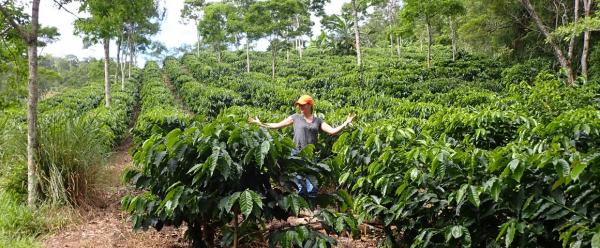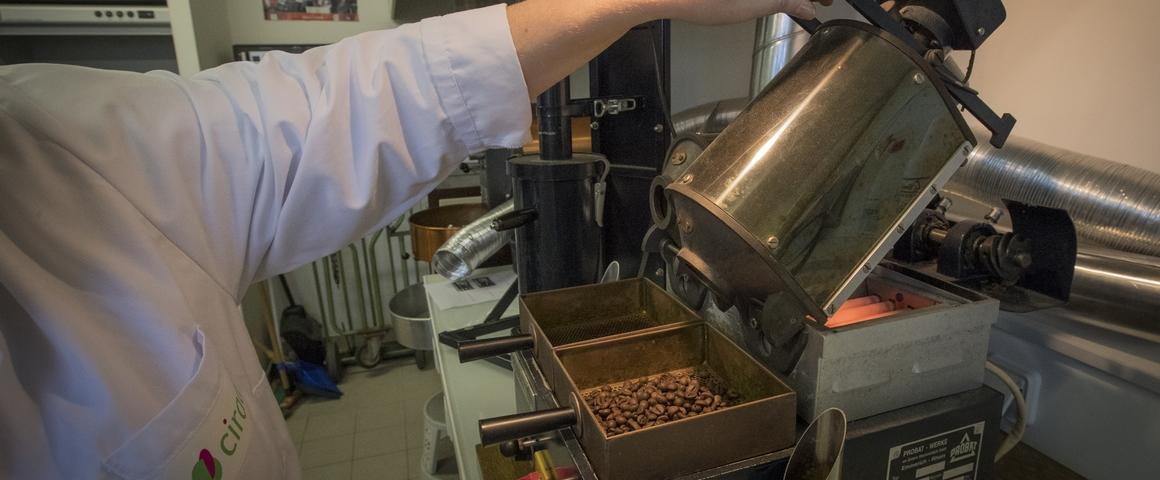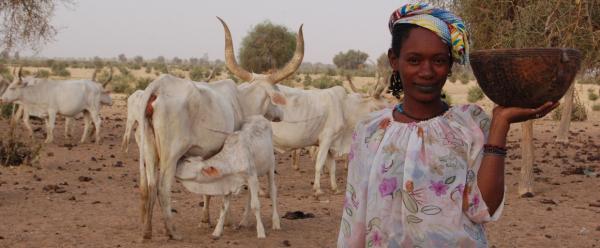A few months after a first event devoted to cotton, Max Havelaar France has held a second "Rencontres scientifiques de Max Havelaar France" meeting, this time on coffee. The event centred on implications of climate change for coffee growing and the urgent need to rethink coffee marketing methods.
The event was organized in collaboration with CIRAD, and the cycle highlights the importance of bringing together scientists, producers, economic players and members of civil society to reflect upon the future of agricultural value chains.
Climate disruption is affecting coffee production conditions
"Until now, in North Kivu, there were two seasons in terms of production: a minor one from February to May, and the main one from September to December. The seasons are now out of sync and the trees flower earlier than before. Heavy rains hamper harvesting, and we are fighting soil erosion. The agricultural calendar has been disrupted and this is affecting yields."
Bertrand Paluku Isevulambire works for the Conseil Agricole Rural de Gestion (rural agricultural management advisory body) in DR Congo. He provides several cooperatives with agricultural and commercial support, including the one in Kawa Kanzurururu, to which more than 2000 coffee producers in North Kivu, eastern DR Congo, belong. The cooperative, which specializes in high quality Arabica, has been working with Max Havelaar France for several years. To cope with climate change, which is substantially affecting both producers and bean quality, the cooperative has requested help from the government, several private firms and foundations, and scientific partners. The cooperative is not far from the Virunga National Park, in a zone particularly prone to conflict. It is therefore vital to preserve the environment and maintain activities that generate income, to safeguard ecosystems and make producers financially independent.
Agroforestry is one of the main solutions rolled out across the cooperative members' farms. "Shade trees help fight soil erosion and also preserve biodiversity", says Bertrand Paluku Isevulambire. "Our producers are based around a national park, so they avoid using chemicals, which is good news for the environment, coffee quality, and their own health."
Might agroforestry be good for both the environment and the economy?
In response to increased temperatures and irregular rainfall, cropping systems based on using shade trees look like an ideal solution. But what about their agronomic performance? Agroforestry systems currently give lower short-term yields than monoculture plots in full sunlight. However, recent studies have highlighted new coffee varieties suited to shade that are performing better and better**. The snag is that smallholders do not have the money to buy such material and develop the crop management sequences required to make the switch. With this in mind, how can agroforestry be seen as a viable alternative, and how might it be rolled out?
"In some territories, we will not be able to switch to agroforestry in the next few years, unless we stop growing coffee. Rising temperatures will reduce the area on which Arabica can be grown in full sunlight and increase that available for Robusta. However, Arabica aroma quality is better and it fetches higher prices." For Guillaume David, Deputy Coffee Value Chain Research Coordinator at CIRAD, we need to rethink how we perceive profitability when it comes to agroforestry: "calculations are still based on varieties bred to be grown in full sunlight. Recent varietal improvements and the creation of hybrid varieties suited to agroforestry are beginning to swing the balance in favour of agroforestry. Moreover, planting trees or hedges helps farmers to reduce their use of inputs, which are increasingly expensive and are a threat to the environment. Coffee produced in agroforestry systems is also better quality, and therefore fetches higher prices. Lastly, some shade tree species can, also be exploited and produce extra income."
In addition to varietal improvement, making the most of the higher price fetched by coffee grown under shade is another central challenge. For example, this could mean certifying sustainable cropping systems, or taking greater account of the adverse environmental consequences of conventional coffee growing.
En Amérique centrale, les caféiers grandissent dans l’ombre d’autres arbres. Ces systèmes de cultures appelés « agroforesterie » permettent une meilleure résilience face aux aléas climatiques. Dans ce troisième épisode de la nouvelle saison du podcast du Cirad, on vous invite à explorer le futur du café à travers les paysages agroforestiers du Nicaragua.
Fair trade for fair coffee prices
Coffee is the second most traded product in the world, just behind oil. There are two billion consumers for 25 million producers, most of whom have less than five hectares at their disposal. And between the two, just three traders share some 50% of the market, while five roasters account for 45% (see the Basic study "Café : la success story qui cache la crise", 2018). This domination of the market puts these major traders and roasters in a strong position to negotiate the green coffee prices paid to producers.
However, coffee growers do have alternatives. For instance, fair trade certification*** guarantees a minimum price and an additional development bonus that can be invested in community projects of their choice. The NGO Fairtrade/Max Havelaar is working with more than 872 000 coffee producers across around thirty countries.
The NGO supports the idea of bringing producers and consumers closer together, and redistributing the wealth generated by coffee trading and roasting more fairly. "Fair trade certification is helping to put a spanner in the works of a machine that is built on poverty and contributes to climate change", says Blaise Desbordes. That trend is confirmed by Denis Seudieu, Chief Economist at the International Coffee Organization (ICO), for whom any changes in the coffee sector must involve producers' organizations: "cooperatives and associations are the main link between markets and producers. They are also the springboard for any potential solutions in response to climate change. Whatever the planned measures, if we want producers to take them on board, we have to go through cooperatives. They are efficient, work at grassroots level, and provide a link with small-scale, often very different, producers", he adds. "Whether the aim is to negotiate prices or introduce new cropping techniques, it would be far too costly for outside organizations to try to talk to producers one by one. By strengthening cooperatives, we support producers."
Unstable world market prices increase pressure on producers
In recent years and in most exporting countries, the steady liberalization of the sector has led to the dissolution of the semi-public bodies that controlled coffee marketing. "The market reality is that coffee is a commodity whose price reflects the gap between supply and demand", says Philippe Chalmin, Professor of Economic History at Paris-Dauphine University. "A sharp cold snap just before the harvest in Brazil can trigger speculation and destabilize prices on the world market. This puts pressure on producers, and pushes them to adopt practices focusing on short-term profits."
The solution could therefore be to switch from a price-based rationale to a value-based one, which would favour producers who use sustainable production methods. It would enable them to achieve their long-term environmental and social aims while competing effectively with other market players and generating acceptable profit margins. Agroforestry systems, varietal improvement, fair trade and certification systems are all being studied by both private players and the research sector, with one specific aim: making the coffee sector sustainable without leaving anyone by the wayside.
* Based on the latest IPCC emissions scenarios , Bunn et al. estimated the area of agricultural land suitable for coffee worldwide. According to scenario RCP6.0, currently considered to be one of the most likely, that area will shrink by around 50% between now and 2050.
Bunn, C., Läderach, P., Ovalle Rivera, O., & Kirschke, D. (2015). A bitter cup: Climate change profile of global production of Arabica and Robusta coffee. Climatic Change, 129(1), 89–101.
** In 2022, scientists published a meta-analysis compiling more than 200 pieces of data on Arabica coffee yields in open field trials, to compare cultivation in full sunlight and under shade. Almost all the varieties analysed gave lower yields in shaded, in other words agroforestry, systems. However, the authors also pinpointed a certain number of varieties which produced more under shade.
Koutouleas, A., Sarzynski, T., Bertrand, B. et al. Shade effects on yield across different Coffea arabica cultivars - how much is too much? A meta-analysis. Agron. Sustain. Dev. 42, 55 (2022).
*** Blaise Desbordes, Director General of Max Havelaar France, sets out the pillars of the fair trade concept: "Our main challenge is to fight poverty and producers' precarious livelihoods, which is why we promise to pay coffee growers a price bonus of around 10%. Alongside the economic aspects, our activity rests on providing social guarantees to ensure that statutory rights, such as holiday leave, are respected. Our brief obviously also contains a major environmental component, and lastly, the remaining pillar is cooperative democracy. Producers who want to join the movement have to build cooperatives".
Read the summary of the meeting (in French)





























